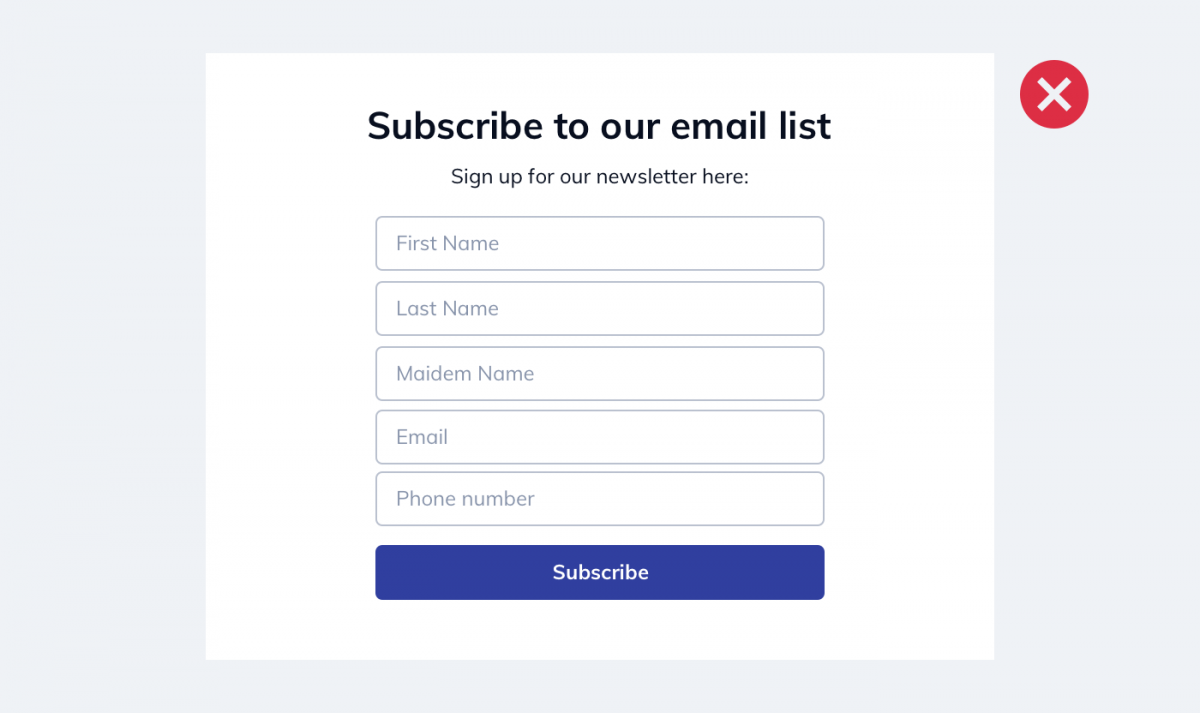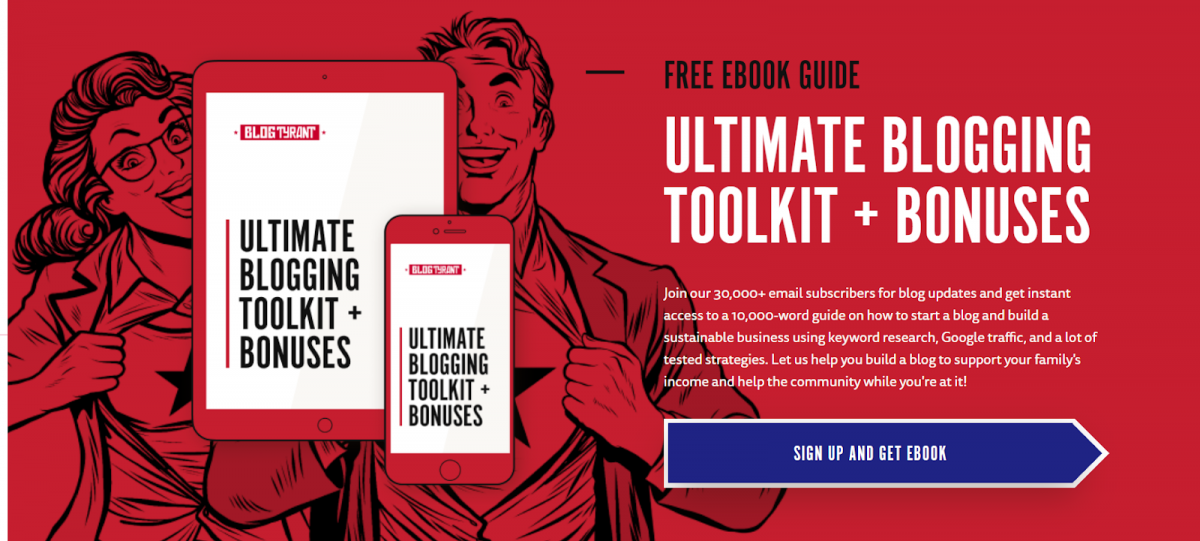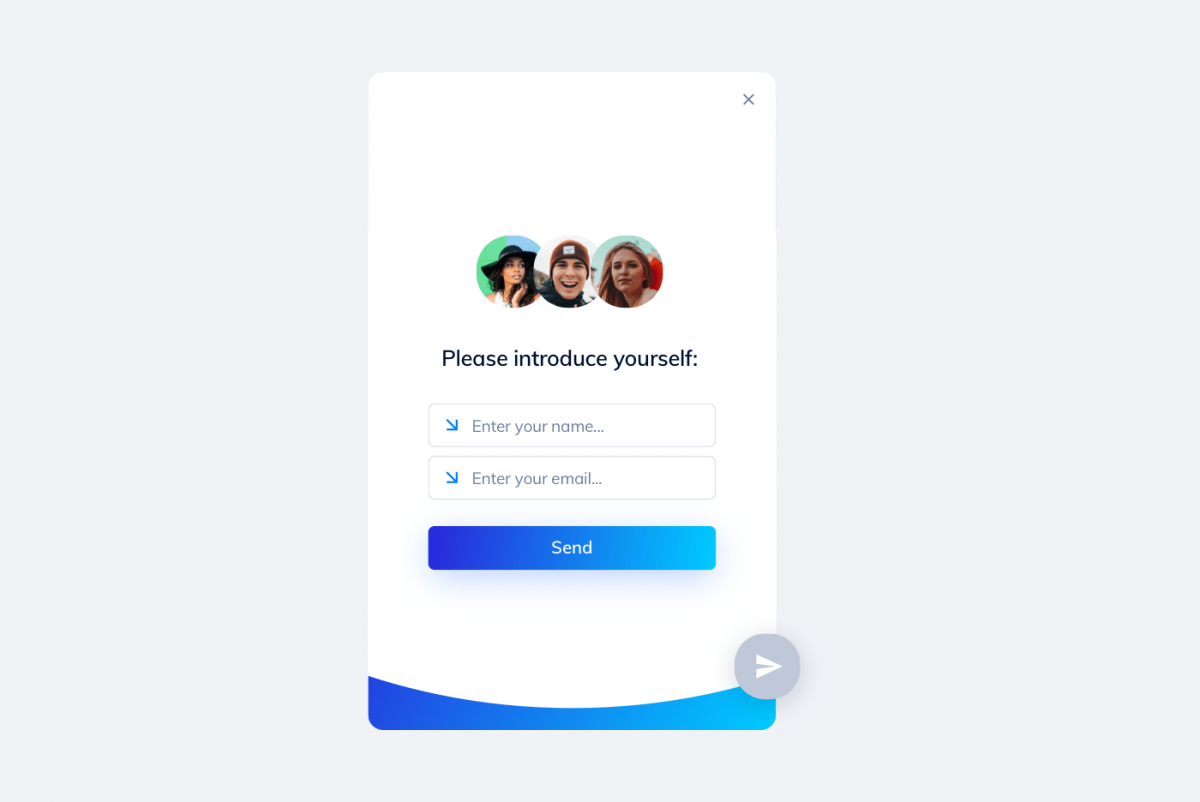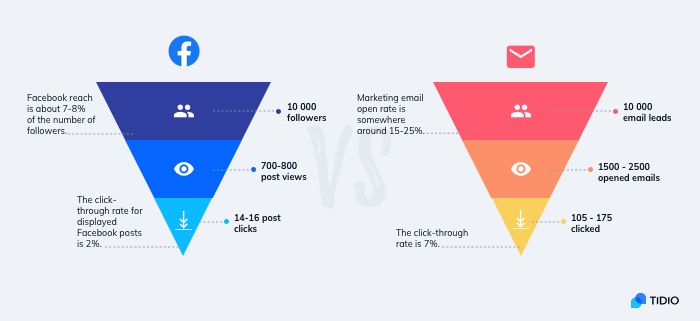If you’ve ever tried to build an email list, you know that it can be tricky. There are many common myths and misconceptions regarding the process.
So, how to build an email list from scratch?
Don’t listen to those who recommend using public resources to collect emails. It is tempting to collect email addresses from the contact pages of various websites. Or to browse your inbox to copy/paste some random addresses.
How about that guy who spammed you some time ago and forgot to use the Blind Carbon Copy field?
It seems easier than taking candy from a baby, right?
Spoiler alert:
Email lists built this way are pretty useless. You also can’t buy email lists.
Easily capture and segment contacts for your email lists with Tidio chatbots
Want to explore other email-related areas? Have a look at these articles:
- 25 Customer Service Email Templates [+Best Practices]
- How to Create a Professional Email Signature [Tips & Examples]
- 10 Best Email Marketing Templates [Free Download]
- How to Write Email Subject Lines to Boost Open Rates [Examples]
- Free Email Newsletter Templates & Examples
- 20+ Best Email Opening Sentences & Greetings [Email Starters]
- Professional Email Header Design: 7 Best Practice Examples
- How to Write a Professional Email [Email Format & Examples]
- Best Time to Send Emails: What Studies & Practice Tell Us
How to Build an Email List from Scratch in Simple Steps
The best things in life are free. However, there is no such thing as a free email list that you can just google and copy. A proper “free” email list is the one you build yourself. After all, you need your email contacts’ consent to send commercial emails.
Here’s how to do it the right way.
Take a look at our free step by step guide to building email lists from scratch.
Step 1: Use Opt-In Forms
Display opt-in forms when people open your website. Encourage your visitors to leave their email addresses. Opt-in forms came in many different… forms. Some of the most effective places you can put your opt-ins inside are modals, interstitials, pop-ups, and chatbot conversations.
People don’t like receiving emails if there are no ways they can get something from them. Because of that, you should think hard about your opt-ins design, copy, and call to action buttons. Signing up for emails shouldn’t feel like signing up for emails but like signing up for an adventure. “Become a shopping superstar!” sounds much more exciting than “Subscribe to our biweekly newsletter about new products.”
An Example of a Good Opt-In Form

- It uses words that encourage to take action, such as “get”, “download”, “free”
- The picture of the book shows what visitors can receive as a gift for leaving their emails
- The CTA button grabs attention through its size, color, and words that are used
- The number of input fields is limited to the bare minimum
This opt-in is visually attractive and it offers value to your visitors. The CTA gives you a clue of what exactly will happen when you sign up. The free ebook is tempting and visitors are teased with the actual cover. Additionally, there is a notification about terms and conditions.
An Example of a Bad Opt-In Form

- The copy is boring and repetitive
- There are no visual elements that would draw attention – the design looks very flat
- There are many unnecessary input fields in the form that can discourage visitors from signing up
- There are no instant benefits for potential subscribers
The opt-in form above looks very poor and is not clear. There are no benefits and any incentives that would motivate or encourage users to leave their email. The CTA is generic and it doesn’t stand out. By today’s digital marketing standards, this opt-in is downright offensive. To add insult to the injury, users are asked to provide far too many personal and contact details.
Step 2: Optimize Your CTA Buttons to Get More Email Leads
CTA is the single most important element you can change to optimize your conversion. You can replace different designs and copy every week and monitor their effectiveness. Did the new version help to encourage your visitors to sign up and add their email address to your email list? If not, change it again.
Let’s take a look at an example.
Everly is a company that makes sugar-free powdered drink mixes. Their online store used popups to collect emails, but their subscription rate was very low. It turned out that discounts and generic CTAs didn’t work.

After extensive testing, they managed to come up with a new popup. This time, they offered exclusive content related to their customers’ interests – an ebook about the ketogenic diet.
Instead of giving away discounts, they made their opt-in form more contextual and linked with both their organic blog visitors search intent (health and diet tips) and their stock (a sugar-free diet product).
When Everly added this popup to their blog and promoted their keto articles on Facebook using a CPL campaign, they were able to increase their popup conversion rate from 1% to 19% and grow their list significantly.
Shauna Ward
from Matcha
How to build an email list? Make the flow between visiting your website and signing up as smooth and contextually relevant as possible. Nail your CTAs and find that sweet spot where yours and your visitors’ interests overlap.
Step 3: Offer Gifts and Freebies for Leaving Emails
If you want people to give you permission to add them to your email list, give them something in return. Everyone likes to receive gifts. Offer coupons, discounts, trials, or freebies to get more email addresses.
Discounts are great as opt-in gifts. You are giving away something that doesn’t cost you anything until someone uses it. And when someone does use it, you get a new customer and still make a profit!
Downloadable freebies are also some of the most tempting and effective incentives. Ask for an email and give an e-book, a free sample of your product, or access to some exclusive materials in return.
Here’s an example of a freebie that encourages visitors to leave their email addresses.

Blog Tyrant offers a free ebook about starting a successful blog.
One strategy we use to build our email list is to offer a lead magnet. A lead magnet is basically a freebie you offer your website visitors in exchange for their email addresses.
Allison Hott
from Blog Tyrant
What are the best freebies and samples you can give for joining your email list?
- Downloadable podcasts
- Premium articles on your blog
- Free video courses
- Packs of thematic graphics
- Trial versions of your software
- Physical gadgets and merchandise
Step 4: Use Your Blog to Get Emails and Generate Leads
Content marketing is one of the best ways of getting new customers. Write interesting and Google-friendly articles on your blog to generate traffic. People who visit your thematic blog – if your blog posts are relevant enough – should be more likely to become interested in your product.
You should try to determine the profile of your potential readers. Match it with your brand’s persona. You’ll get newsletter subscriptions, new accounts created, and new addresses added to your email list in no time.
Blog readers make far better leads than random visitors. For example, you can set up a pop-up or a modal opt-in form that displays after 30 seconds of reading a post.
Step 5: Use a Live Chat Widget to Collect Emails

Every modern business or eCommerce website should have a live chat option. Being able to connect with a customer support team through a messaging app is the greatest thing since sliced bread. It makes customer service quick, easy, and natural. The experience is so frictionless that you can actually add some friction by asking customers to leave their emails. You’ll still be on the safe side.
Some of the best email marketing platforms offer all-in-one live chat and email integration. That means that you can build your email lists and send email campaigns with the same app. No need to import/export data!
You can also make your visitors leave their email addresses before they even start chatting. They will need to comply with your terms to continue their conversation. Some customers may find it mildly irritating but, in the long run, it will help to forge a better customer relationship. Live chat is not the only place you can hide an opt-in form in disguise. A comment section may also be a good place.
Step 6: Use CRM Tools for Email List Management
For all that matters, you could possibly build an email list in Notepad as a CSV file. But it is far better to integrate your email list with your mailing tool. You can’t really create professional email campaigns in Gmail, so you’ll have to use one.

If you are a small-business owner, you can use an all-in-one solution that takes care of your customer support, lead generation, live chat, chatbots, email list management, and mailing. Tools like Tidio can be really handy because you can take care of your customer service and mailing from one dashboard. It’s far better than navigating through several different applications.

The diagram above shows a strategy you can use to build email lists and increase the effectiveness of your mailing campaigns and your sales.
There are many strategies you can use to collect people’s emails. One of the most important things you should always remember is that your email list must be legit. To make it meet the CAN-SPAM Act requirements, you should use opt-in forms. Email address harvesting is strictly prohibited.
What Is the CAN-SPAM Act?
The CAN-SPAM (The Controlling the Assault of Non-Solicited Pornography And Marketing Act of 2003) is the most important legal act that sets standards and rules for sending commercial emails.
According to the CAN-SPAM Act, you need to:
- Include an option to unsubscribe
- Provide a legitimate physical address of your company
- Send emails only to people from your legal email list
The recipients of your email marketing campaigns should explicitly confirm their interest in your brand or product. If you buy an email list, you can get into trouble.
Email vs Social Media – Is Email Dead?
Email is not sexy. It’s old and boring. For the young generation, writing emails seems old-fashioned. It’s something the adults do at work. Social media are far more popular and entertaining.
So, we should use social media for advertising instead of email, right?
Wrong!
According to popular opinion, email marketing is dead. Nothing could be further from the truth. Contrary to what people say, email marketing is still alive and kicking.
People scroll through the height of the Empire State Building twice (!) while using Facebook for a week. It’s more difficult than ever to grab their interest. But they still receive only a handful of emails.

Posting on Facebook is easy and natural – everyone knows how to do it. As a result, everybody does it!
Creating a professional email campaign is a little bit more tricky. Most people wouldn’t know where to start. Designing an email template? Building an email list through opt-in forms? Getting newsletter subscribers with a chatbot?
Worry not. As it happens, we do have the tools and we will show you how to use them. But let’s take a look at some statistics before we start building your email list.
Why Email List Is Important
You may find it hard to believe, but email is the most effective and cheapest form of online marketing. An experienced marketer will take a good email list of over a thousand likes on Facebook any day of the week!

Organic social media visibility is very low. A Facebook organic reach is only around 5-10% and in some cases, it drops down to a measly 2%.
Let’s do some math to prove that having an email list of 10 000 users is better than having 10 000 followers on Facebook.
On average, Facebook’s reach is about 7-8% of the number of followers. The click rate for displayed Facebook posts is 2%. That means:
10 000 Facebook followers = 700-800 post views = 14-16 post clicks
It doesn’t look very impressive, does it?
Let’s crunch the numbers for an average email campaign.
The average marketing email open rate is somewhere around 15-25%. The click-through rate is 7%.
10 000 email leads = 1500-2500 email views = 105-175 email clicks

It should be pretty obvious that getting 175 clicks is far better than 16 clicks. Email marketing is approximately 10 times more effective. It always has the lowest cost per conversion among all marketing channels.
So, emails can be more effective than social media. Do you know what’s the best news? Building an email list of 1000 leads is far easier than getting 1000 followers on Facebook. You can automate the whole workflow of getting new customers on your email list.
Try Tidio to see how easy building email lists and communicating with your clients can be.
Easily capture and segment contacts for your email lists with Tidio chatbots

